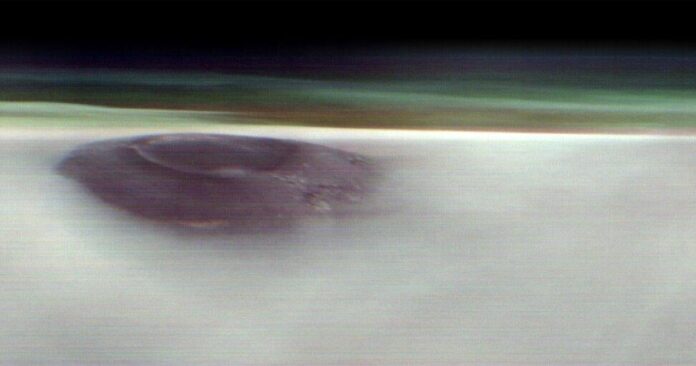A dazzling image taken by NASA’s 2001 Mars Odyssey orbiter shows an unprecedented view of a 12-mile-high volcano poking through clouds at dawn on the Red Planet.
Arsia Mons, which dwarfs Earth’s tallest volcanoes, and its two neighboring volcanoes are often surrounded by water ice clouds, especially in the early morning. The image released Friday marks the first time one of the volcanoes has been imaged on the planet’s horizon, NASA said.
Odyssey has previously captured high-altitude images of the Martian horizon, and to do so, it rotates 90 degrees while in orbit so that its camera can take the picture, NASA said. The spacecraft typically focuses on the upper atmosphere but also studies surface features.
The latest image, captured on May 2, focuses on Arsia Mons, which is roughly twice as tall as Earth’s largest volcano, Hawaii’s Mauna Loa, which rises 6 miles above the seafloor.
NASA
Arsia Mons is the cloudiest of the three volcanoes in the area — collectively called the Tharsis Mountains — and the clouds are especially thick when the Red Planet is farthest from the sun, a period called aphelion.
The new snapshot clearly shows the cloud canopy across the Red Planet’s equator.
“We picked Arsia Mons hoping we would see the summit poke above the early morning clouds. And it didn’t disappoint,” said Jonathon Hill, the operations lead for Odyssey’s camera, called the Thermal Emission Imaging System, or THEMIS.
The angle of the camera allows scientists to see dust and water ice cloud layers, enabling them to observe changes over the course of seasons.
“We’re seeing some really significant seasonal differences in these horizon images,” said planetary scientist Michael D. Smith of NASA’s Goddard Space Flight Center. “It’s giving us new clues to how Mars’ atmosphere evolves over time.”
Launched in 2001, Odyssey has the distinction of being the longest-running spacecraft orbiting another planet.
NASA’s Perseverance rover, which landed on Mars in 2021, is collecting samples for an eventual return to Earth from Jezero Crater, an ancient lakebed and river delta that could hold clues to any past microbial life. Last month, Perseverance took a selfie that captured an image of a dust devil popping up about 3 miles behind the rover.
